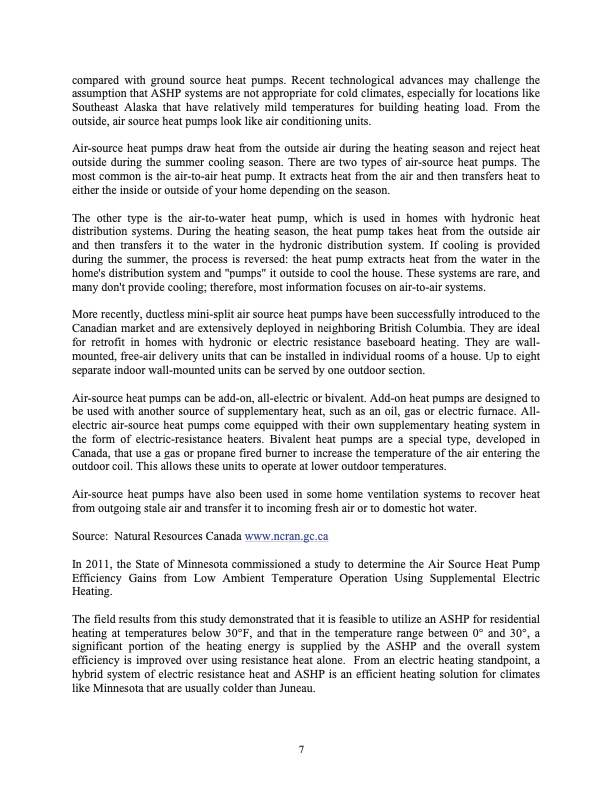
PDF Publication Title:
Text from PDF Page: 007
compared with ground source heat pumps. Recent technological advances may challenge the assumption that ASHP systems are not appropriate for cold climates, especially for locations like Southeast Alaska that have relatively mild temperatures for building heating load. From the outside, air source heat pumps look like air conditioning units. Air-source heat pumps draw heat from the outside air during the heating season and reject heat outside during the summer cooling season. There are two types of air-source heat pumps. The most common is the air-to-air heat pump. It extracts heat from the air and then transfers heat to either the inside or outside of your home depending on the season. The other type is the air-to-water heat pump, which is used in homes with hydronic heat distribution systems. During the heating season, the heat pump takes heat from the outside air and then transfers it to the water in the hydronic distribution system. If cooling is provided during the summer, the process is reversed: the heat pump extracts heat from the water in the home's distribution system and "pumps" it outside to cool the house. These systems are rare, and many don't provide cooling; therefore, most information focuses on air-to-air systems. More recently, ductless mini-split air source heat pumps have been successfully introduced to the Canadian market and are extensively deployed in neighboring British Columbia. They are ideal for retrofit in homes with hydronic or electric resistance baseboard heating. They are wall- mounted, free-air delivery units that can be installed in individual rooms of a house. Up to eight separate indoor wall-mounted units can be served by one outdoor section. Air-source heat pumps can be add-on, all-electric or bivalent. Add-on heat pumps are designed to be used with another source of supplementary heat, such as an oil, gas or electric furnace. All- electric air-source heat pumps come equipped with their own supplementary heating system in the form of electric-resistance heaters. Bivalent heat pumps are a special type, developed in Canada, that use a gas or propane fired burner to increase the temperature of the air entering the outdoor coil. This allows these units to operate at lower outdoor temperatures. Air-source heat pumps have also been used in some home ventilation systems to recover heat from outgoing stale air and transfer it to incoming fresh air or to domestic hot water. Source: Natural Resources Canada www.ncran.gc.ca In 2011, the State of Minnesota commissioned a study to determine the Air Source Heat Pump Efficiency Gains from Low Ambient Temperature Operation Using Supplemental Electric Heating. The field results from this study demonstrated that it is feasible to utilize an ASHP for residential heating at temperatures below 30°F, and that in the temperature range between 0° and 30°, a significant portion of the heating energy is supplied by the ASHP and the overall system efficiency is improved over using resistance heat alone. From an electric heating standpoint, a hybrid system of electric resistance heat and ASHP is an efficient heating solution for climates like Minnesota that are usually colder than Juneau. 7PDF Image | Heat Pump Technology

PDF Search Title:
Heat Pump TechnologyOriginal File Name Searched:
jcos_heat_pump_technology.pdfDIY PDF Search: Google It | Yahoo | Bing
CO2 Organic Rankine Cycle Experimenter Platform The supercritical CO2 phase change system is both a heat pump and organic rankine cycle which can be used for those purposes and as a supercritical extractor for advanced subcritical and supercritical extraction technology. Uses include producing nanoparticles, precious metal CO2 extraction, lithium battery recycling, and other applications... More Info
Heat Pumps CO2 ORC Heat Pump System Platform More Info
| CONTACT TEL: 608-238-6001 Email: greg@infinityturbine.com | RSS | AMP |